The Moon appears to change in the sky. One moment it’s a big white circle, and next week it’s shaped like a sideways bike helmet. There’s even a day where it disappears altogether. So what gives?
The Sun illuminates half of the Moon all the time. Imagine shining a flashlight on a beach ball. The half that faces the light is lit up. There’s no light on the far side, right? For the Moon, which half is lit up depends on the rotation of the Moon. And which part of the illuminated side we can see depends on where we are when looking at the Moon. Sound complicated? This lab will straighten everything out so it makes sense.
Materials
- ball
- flashlight


This is even better: here’s an animation from Nasa that you can interact with!
https://solarsystem.nasa.gov/planets/overview/
And yes we have orbit experiments with Kepler’s System here:
https://www.sciencelearningspace2.com/2019/02/keplers-swinging-system-2/
Is there a video on the ecliptic orbit of the moons and planets?
I am not sure what you mean by the “moon is always tilted up”. The moon, sun, and planets follow an arc across the sky called the ecliptic. When the moon and sun overlap, we get an eclipse. Total solar eclipses happen when the moon crosses between the sun and Earth.
If the moon is always tilted up, how do we even get any eclipses?